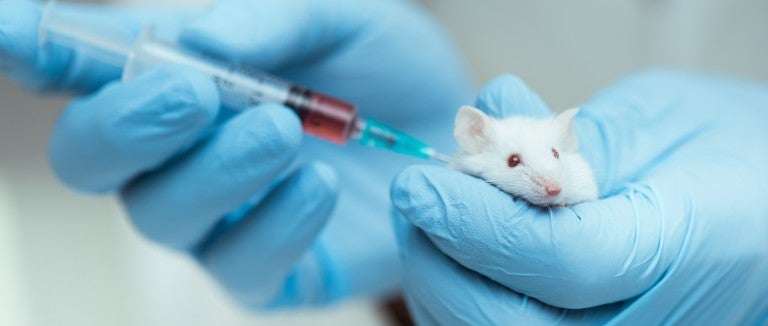For decades, animal welfare advocates have been working to end animal testing for makeup and personal care products. See how far we've come and how you can help support the Be Cruelty-Free campaign, our global effort to end cosmetic cruelty.
Read Our Cosmetics Testing FAQ
2024 | 2023 | 2022 | 2021 | 2020 | 2019 | 2018 | 2017 | 2016 | 2015 | 2014 | 2013 | 2000-2012 | 1980-1999 | 1938-1979
2024
March: Washington passes a ban on the sale of animal-tested cosmetics.
2023
December: Chile passes a law to ban cosmetics animal testing and the sale of animal-tested cosmetics.
August: Oregon passes a ban on the sale of animal-tested cosmetics.
June: Canada passes a law to ban cosmetics animal testing and the sale of animal-tested cosmetics.
March: Brazil bans cosmetics animal testing.
2022
December: New York passes a ban on the sale of animal-tested cosmetics.
June: Louisiana passes a ban on the sale of animal-tested cosmetics.
June: The Organisation for Economic Cooperation and Development (OECD) approves new non-animal test methods for eye irritation and skin allergy.
2021
December: The federal Humane Cosmetics Act, legislation to prohibit cosmetics animal testing and the sale of animal-tested cosmetics, is reintroduced in the U.S.
November: New Jersey passes a ban on the sale of animal-tested cosmetics.
September: Mexico passes a law to ban cosmetics animal testing and the sale of animal-tested cosmetics.
July: Hawai'i passes a ban on the sale of animal-tested cosmetics.
June: Maine passes a ban on the sale of animal-tested cosmetics.
June: The Organisation for Economic Cooperation and Development (OECD) approves new non-animal test methods for skin allergy and phototoxicity.
May: Maryland passes a ban on the sale of animal-tested cosmetics.
May: New cosmetics regulations go into effect in China, opening a potential pathway for the import of so-called “ordinary” cosmetics, such as shampoo and mascara, without the need for additional animal testing.
March: Virginia passes a ban on the sale of animal-tested cosmetics.

2020
December: Chile introduces a bill to ban cosmetics animal testing and the sale of animal-tested cosmetics.
August: Colombia passes a law to ban cosmetics animal testing and the sale of animal-tested cosmetics.
March: The Mexican Senate passes a bill to ban cosmetics animal testing and the sale of animal-tested cosmetics.
January: Laws banning the sale of animal-tested cosmetics go into effect in California, Illinois and Nevada.
2019
November: The federal Humane Cosmetics Act, legislation to prohibit cosmetics animal testing and the sale of animal-tested cosmetics, is reintroduced in the U.S. with support from the cosmetic industry.
November: The Organisation for Economic Cooperation and Development (OECD) approves a new non-animal test method for eye irritation.
September: Illinois passes a ban on the sale of animal-tested cosmetics.
June: Nevada passes a ban on the sale of animal-tested cosmetics.
June: The Organisation for Economic Cooperation and Development (OECD) approves new non-animal test methods for eye irritation, skin irritation, skin allergy and phototoxicity.
June: Estée Lauder announces its support for the #BeCrueltyFree campaign.
April: Avon announces its support for the #BeCrueltyFree campaign.
March: Australian government passes a ban on the use of new animal data for cosmetics safety.
February: Procter & Gamble (P&G) announces its support for the #BeCrueltyFree campaign.
2018
October: Unilever announces its support for the #BeCrueltyFree campaign.
September: California passes a ban on the sale of animal-tested cosmetics.
July: Minais Gerais, Brazil passes a ban on cosmetics animal testing.
June: The Organisation for Economic Cooperation and Development (OECD) approves new non-animal test methods for skin allergy.
June: Canada Cruelty-free Cosmetics Act, legislation to ban cosmetics animal testing and the sale of animal tested ingredients, passes the Senate.
2017
December: Rio de Janeiro, Brazil bans cosmetics animal testing and the sale of animal-tested cosmetics.
December: South Africa introduces legislation to ban cosmetics animal testing and the sale of animal-tested cosmetics.
October: The Organisation for Economic Cooperation and Development (OECD) approves new non-animal test methods for eye irritation and skin allergy.
June: The Humane Cosmetics Act, legislation to prohibit cosmetics animal testing and the sale of animal-tested cosmetics, is reintroduced in the U.S.
February: Guatemala becomes the first country in the Americas to ban cosmetics animal testing.
2016
December: Switzerland passes an ordinance to ban the sale of animal-tested cosmetics, effective May 2017.
October: Taiwan bans cosmetic animal testing for finished products and ingredients, effective 2019.
July: The Organisation for Economic Cooperation and Development (OECD) approves a new non-animal test method for skin allergy.
June: Australia’s federal government announces its commitment to ban the production and sale of animal-tested cosmetics by July 2017.
March: The Swiss government announces it will take measures to ban the sale of cosmetics containing ingredients tested on animals.
February: The Ethical Cosmetics Bill, legislation to end the production and sale of animal-tested cosmetics and cosmetic ingredients, is introduced in the Australian House.
November: India bans the import of animal-tested cosmetics.
2015
December: South Korea passes a law to partially ban the manufacture and sale of animal-tested cosmetic products and ingredients if government-recognized, non-animal alternatives exist.
December: The Cruelty-Free Cosmetics Act is reintroduced in Canada.
September: Russia introduces a bill to phase out the production and sale of animal-tested cosmetics and cosmetic ingredients if validated alternatives exist.
September: Brazilian Senator proposes amendments to cosmetics bill to include a ban on animal-tested ingredients and the sale of animal-tested cosmetics.
July: Turkey bans cosmetic animal testing and the sale of animal-tested cosmetic products and ingredients where a validated alternative exists, effective January 2016.
July: The Organisation for Economic Cooperation and Development (OECD) approves additional non-animal alternative tests for eye and skin irritation as well as tests for skin allergy.
June: The Humane Cosmetics Act, legislation to prohibit cosmetic animal testing and the sale of animal-tested cosmetics, is reintroduced in the U.S.
June: Canada introduces the Cruelty-Free Cosmetics Act, legislation to ban cosmetic animal testing and the sale of animal tested ingredients.
April: Taiwan introduces legislation to ban cosmetic animal testing and the sale of animal tested ingredients.
March: New Zealand bans cosmetic animal testing for finished products and ingredients intended exclusively for use in cosmetics.
March: South Korea introduces legislation to ban the manufacture and sale of some animal-tested cosmetics if government-recognized, non-animal alternatives exist.

2014
November: India bans the import of animal-tested cosmetics.
June: China implements a rule to remove mandatory animal testing for so-called ”ordinary” cosmetics, such as shampoo or mascara, manufactured in China.
May: India bans cosmetic animal testing.
March: The End Cruel Cosmetics bill, legislation to end the production and sale of animal-tested cosmetics and cosmetic ingredients, is introduced in the Australian Senate.
March: The Humane Cosmetics Act, legislation to prohibit cosmetic animal testing and the sale of animal-tested cosmetics, is introduced in the U.S.
January: São Paulo, Brazil, bans cosmetic animal testing.
2013
March: Norway bans cosmetic animal testing and the sale of animal-tested cosmetics.
March: The full European Union ban on the sale of animal-tested cosmetics takes effect.
January: Israel implements a prohibition on the sale of all cosmetics that have been tested on animals.
2000-2012
2012: The Organisation for Economic Cooperation and Development (OECD) approves a second alternative for eye irritation.
2011: The European Union ban on animal testing of cosmetic ingredients and sale of cosmetic products and ingredients tested on animals goes into effect in all but a few test areas.
2010: Israel passes a law to phase out the sale of animal-tested cosmetics.
2010: The Organisation for Economic Cooperation and Development (OECD) approves a non-animal test method for skin irritation.
2009: The Organisation for Economic Cooperation and Development (OECD) approves a non-animal test methods for eye irritation.
2008: New York passes a law requiring companies to use test methods validated by the Interagency Coordinating Committee on the Validation of Alternative Methods (ICCVAM).
2007: New Jersey passes a law requiring companies to use test methods validated by the Interagency Coordinating Committee on the Validation of Alternative Methods (ICCVAM).
2007: Israel bans the use of animals to test cosmetics.
2006: The Organisation for Economic Cooperation and Development (OECD) approves a second non-animal test method for skin corrosivity.
2005: The Japanese Center for the Validation of Alternative Methods (JaCVAM) is established.
2004: The Organisation for Economic Cooperation and Development (OECD) approves non-animal test methods for skin absorption, skin corrosivity and skin phototoxicity.
2004: The European Union passes a law phasing out the production and sale of animal-tested cosmetics.
2000: California becomes the first state to pass a law requiring companies to use test methods validated by the Interagency Coordinating Committee on the Validation of Alternative Methods (ICCVAM).
2000: The Interagency Coordinating Committee on the Validation of Alternative Methods (ICCVAM) Authorization Act is signed. This law established a coordinated effort by United States agencies to evaluate and adopt test methods that reduce, refine or replace the use of animals.
Make a difference for dogs, rabbits, guinea pigs, mice and rats when you shop. Choose cruelty-free cosmetic brands that don’t test on animals.

1980-1999
1998: The United Kingdom bans animal testing for cosmetic products and ingredients.
1996: Animal protection groups band together to form the Coalition for Consumer Information on Cosmetics. The coalition manages the Leaping Bunny cruelty-free certification program in the United States and Canada.
1991: The European Centre for the Validation of Alternative Methods is established to oversee the development and acceptance of alternative test methods that reduce, refine and replace the use of animals.
1980: Advocate Henry Spira wages a successful campaign to get cosmetics company Revlon to stop using the Draize test, which requires directly exposing animals’ eyes and skin to chemicals and causes extensive animal suffering.
1938-1979
1944: Draize irritancy tests, which require directly exposing animals’ eyes and skin to chemicals, are developed. Considered for decades to be the gold standard for cosmetic safety assessments, these tests cause extensive animal suffering.
1938: The United States Food, Drug & Cosmetic Act is signed into law, requiring some safety substantiation of cosmetic products. This compels companies to begin testing their products on animals.
